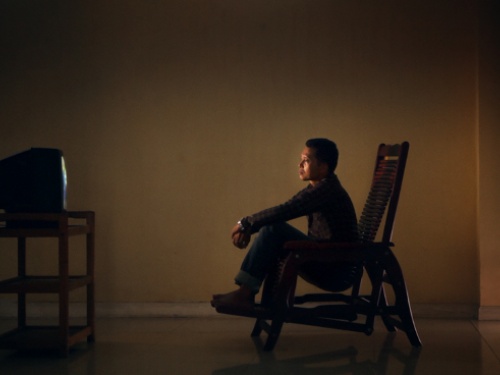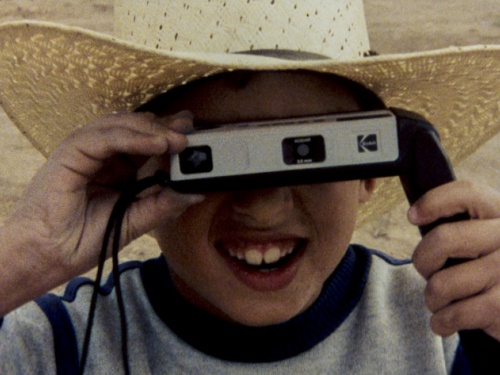Aesthetics of the Frame
What are the ethical and political implications of the way in which documentaries frame reality? Ahead of the opening of our inaugural Frames of Representation festival, writer and academic Ilona Hongisto discusses the documentary frame: its ethics, its (de)construction of the periphery, and its negotiation of the relationship between the present and the future.
Frames of Representation (FoR) is a film festival which showcases new forms of documentary cinema and invites discussion around the issues represented on screen.
The frame marks a territory. It institutes a limit between the inside and the outside. Hence the inside of a documentary frame—what is perceivable within it—is contested ground; who or what gets to occupy the territory demarcated by the frame is determined by the historical moment, its social hierarchies and political dues. The inside of the frame is determined by what remains outside the frame.
Documentary frames of representation are generally renowned for focusing on those who are excluded from official histories and who live outside the habitual. Documentary cinema, in other words, has taken it upon itself to bring the other side into the frame. This is often characterized as giving a voice to those who have previously been deprived of such a privilege.
"Documentary cinema has challenged harmful assumptions about 'the other'."
It is undoubtedly true that documentary cinema, by inviting the elsewhere into the frame, has challenged and even changed harmful assumptions and oppressive structures about ‘the other’. Thus, the documentary’s ethical impetus is often located in occupying the inside of the frame with alternative stories and histories. But it is my contention that the work of the frame is much more complex than the shifting limit between the inside and the outside leads us to believe. In short, the frame is an active periphery that pushes the real to actualize.
The documentary films included in this year’s Frames of Representation present the actualizing work of the frame in a number of ways. All of them frame people, places and events that often occupy the margins of representational practices, but instead of being content with inhabiting the frame with alternative content, the documentaries frame the real in a manner that ties the inside of the frame to the outside, to what is yet to come. This, of course, is also what sets the documentary apart from other cinematic modalities; the world captured in documentary films continues beyond the frame.
"The observational frame in Roberto Minervini’s film enables its subjects to become the makers of their own story."
There are many ways for the documentary to attend the limit of what is yet to come, and one of the most tantalizing examples is observation. The observational frame in Roberto Minervini’s The Other Side (Louisiana) (2015) enables the film’s subjects to become the makers of their own story. Here, the intimate observational frame captures the people of West Monroe, Louisiana, doing what they would normally do, but as the camera frames them, it pushes their realities to unfold in particular ways. Most importantly, their anger toward the establishments that have abandoned them becomes pronounced and takes over the film. Within the intimate space of documentary filmmaking, made visible within the frame, anger becomes the sentiment that ties the protagonists together. The observational frame in a sense drives anger to the surface, giving it a form that then also becomes the documentary’s main theme.
Zhao Liang’s monumental Behemoth (2015) abides to a completely different aesthetics of the frame. Combining long shots of industrial machines in the Mongolian grasslands and close-ups of coal mine workers, the documentary envisions a paradise that has turned into purgatory. The juxtaposition of ever-shrinking pasturelands ploughed by machines that quite literally spit fire and the silent portraits of men whose grave faces are layered with dust builds up to the revelation of pristine ‘ghost cities’, empty urban satellites in the desert. In Behemoth, the visual contrast of scale captures environmental destruction and human plight, and gives expression to a paradise lost.
The silent portraits of the workers in Behemoth resonate interestingly with the compositions in Wojciech Staron’s Brothers (2015). A story about two brothers who escaped a Soviet work camp and returned to their home in Poland after 70 years of absence, the documentary traces the bond between the brothers with dual compositions that give expression to their relationship. The silent compositions of the two men are a kind of a sieve between their shared past and the horizon of ailments that comes with age. Hovering in-between, the portraits are a respite from the force of time – moments dedicated to their irreplaceable bond in the face of death.
"Documentary cinema asks us to consider how our actions in the present condition futures that are yet unknown."
The lingering intimacy of the observational frames in The Other Side, the portrait-like compositions of two elderly men in Brothers or the changes of scale in Behemoth indeed do bring the marginal, the exiled, the subjugated into focus. But this is done in a manner that opens the images back to the outside, to what lingers beyond the frame. The Other Side relates anger to a horizon of destruction, Brothers deals with lives waning, and Behemoth envisions a catastrophe beyond imagination. This, I believe, is ultimately the ethical prerogative of the documentary frame: by opening itself up to the outside, the documentary frame relates what is in the frame to realities that are yet to come. In this way, documentary cinema asks us to consider how our actions in the present condition futures that are yet unknown. ■
Ilona Hongisto is Lecturer in Media Studies at Macquarie University, Sydney, and the author of Soul of the Documentary: Framing, Expression, Ethics (Amsterdam University Press, 2015).
Frames of Representation: New Visions for Documentary Cinema runs 20 - 27 April 2016.
This article is posted in: Articles, Blog, Film
Tagged with: Ilona Hongista, Frames of Representation, Aesthetics of the Frame, The Other Side, Roberto Minervini, Behemoth, Brothers, Wojciech Staroń, Zhao Liang, Documentary Film, Film, Films, Documentary, ethics, Ethics of Representation, Luke Moody, Nico Marzano








